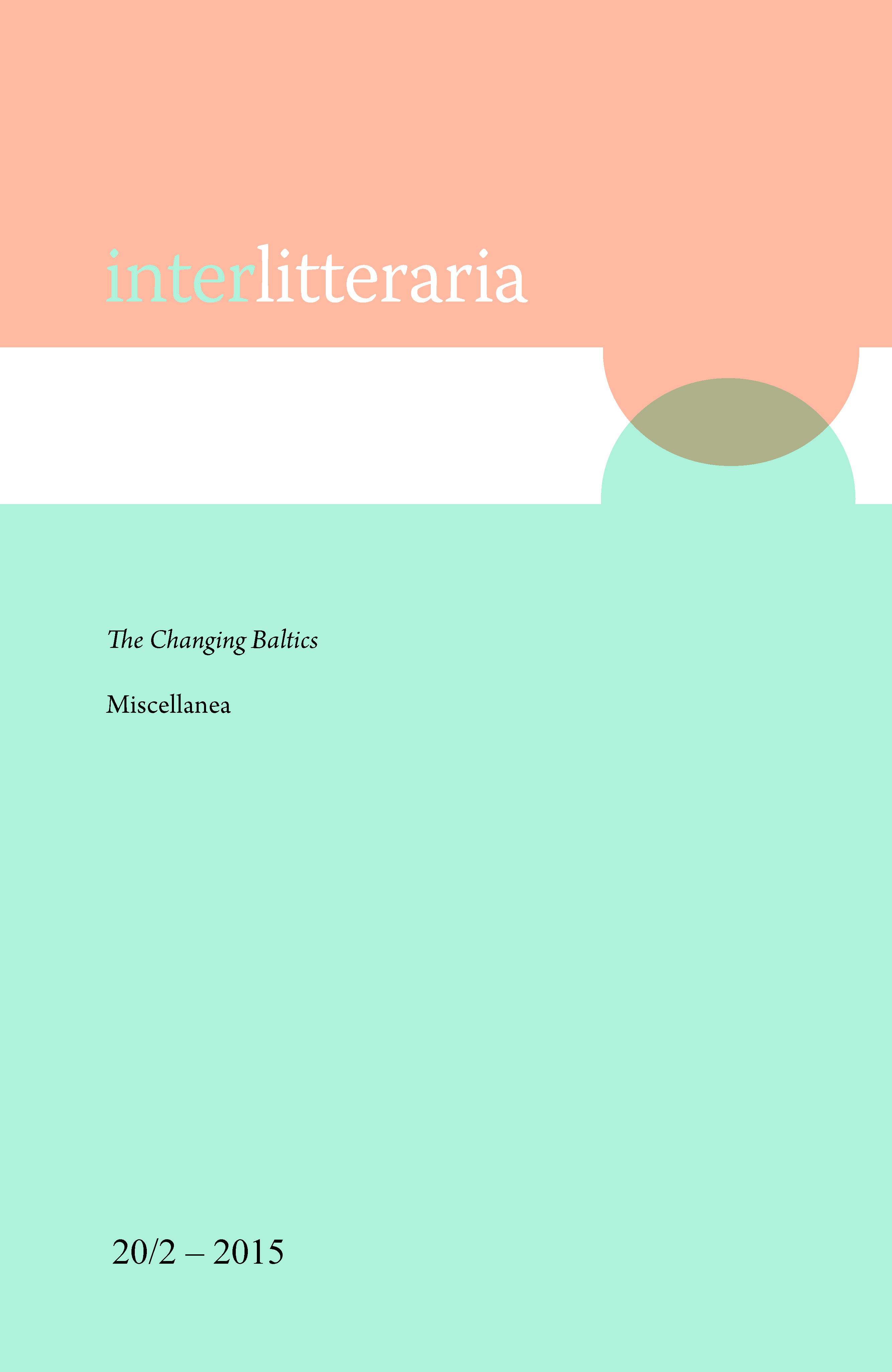Tendencies of Expressionism in Rainis’ Writings: Spēlēju, dancoju (I Played, I Danced, 1915)
DOI:
https://doi.org/10.12697/IL.2015.20.2.2Keywords:
Jānis Rainis, Leonid Andreyev, the First World War, Expressionism, grotesque, living, deadAbstract
The paper focuses upon the specific tendencies of Expressionism in the outstanding Latvian poet and playwright Rainis’ (Jānis Pliekšāns, 1865–1929) writings. Rainis always tried to follow the current trends in art, at the same time elaborating his own specific style of expression, therefore his oeuvre is characterized by a peculiar combination of the traditional and modern or, in other words, specifically Latvian elements combined with European modernist features. One of the brightest examples is his play Spēlēju, dancoju (I Played, I Danced, 1915), which is marked by trends akin to Expressionist art, as well as their very specific translation into Latvian tradition. Although Expressionism in its most impressive manifestation appears in German literature, a kindred world vision can be also found in other countries, in some cases even earlier than in Germany. For instance, expressionistic tendencies are characteristic of the literary works of the Russian writer and playwright Leonid Andreyev (1871–1919). Rainis’ diaries, letters and notes demonstrate a stable and permanent interest in Expressionism and particularly Andreyev. Although the Latvian poet’s attitude to his Russian colleague’s literary works mostly can be characterised as negative, Rainis’ notes show that in Andreyev’s artistic quests he has also found some impulses for his own writings. While exploring the tendencies of Expressionism in Rainis’ writings, the paper discusses the specific use of grotesque and the intensified relations between the living and the dead in the play Spēlēju, dancoju. It is significant that the relations between life and death, the living and the dead is one of the central themes in Expressionism, and its relevance is determined by the political events at the beginning of the 20th century (especially, the First World War), as well as the development of industrial society. In order to demonstrate the most significant points of interaction shared by Spēlēju, dancoju and Expressionism, as well as the uniqueness of Rainis’ artistic manner, the paper gives an insight into the aesthetics of Expressionism and provides a comparative analysis of Rainis’ play and some examples of Expressionist art (e.g., writings by Leonid Andreyev, Georg Kaiser, Ernst Toller).Downloads
Download data is not yet available.
References
<div class="WordSection1"><p>Andreyev, L. 1911. <em>King-Hunger</em>. Boston: Poetlore, 1911. – <a href="http://babel.hathitrust/org/cgi/pt?id=mdp.39015030852423;view=1up;seq=8">http://babel.hathitrust/org/cgi/pt?id=mdp.39015030852423;view=1up;seq=8</a> (07.01.2015.)</p><p>Andreev, L. 1991. <em>P’esy. </em>Moskva: Sovetskij pisatel’. = Андреев, Л. 1991. <em>Пьесы</em>, Москва: Советский писатель.</p><p>Babičeva, J. 1971. <em>Dramaturgija </em><em>L.</em><em> N. Andreeva èpohi </em><em>pervoj</em><em> </em><em>russkoj</em><em> revoljucii.</em><em> </em>Vologda: Vologdskij GPI. = Бабичева, Ю. 1971. <em>Драматургия Л. Н. Андреева эпохи первой русской революции</em>. Вологда: Волoгдский ГПИ.</p><p>Bugrov, B. 1968. Na putjah otrycanija realizma (“Žizn’ čeloveka” i “Car’-Golod” L. Andreeva). – <em>Russkaja literatura XX veka. (Dooktjabrskij period)</em>. Kaluga: Tul’skij GPI im. L. N. Tolstogo, 266–288. = Бугров, Б. 1968. На путях отрыцания реализма (“Жизнь человека” и “Царь-Голод” Л. Андреева). – <em>Русская литература XX века. (Дооктябрский период). </em>Калуга: Тульский ГПИ им. Л. Н. Толстого, 266–288.</p><p>Grigor’ev, A. 1972. Leonid Andreev v mirovom literaturnom processe. – <em>Russkaja literatura</em>, 3, 190–205. = Григорьев, A. 1972. Леонид Андреев в мировом литературном процессе. – <em>Русская литература</em>, 3, 190–205.</p><p>Hausmanis, V. 1973. <em>Raiņa dramaturģija</em>. Rīga: Zinātne.</p><p>Hausmanis, V. 1981. Spēlēju, dancoju: Sacerēšanas gaita. – J. Rainis, <em>Kopoti raksti 30 sējumos</em>, 11. Rīga: Zinātne, 506–511.</p><p>Huizinga, J. 1999. <em>The Waning of the Middle Ages</em>. Mineola, New York: Dover Publications.</p><p>Kaiser, G. (Kaizer, G.). 1923. <em>Dramy</em>. Moskva-Petrograd: Gosizdat. = Кайзер, Г. 1923. <em>Драмы</em>. Москва- Петроград: Госиздат.</p><p>Kalnačs, B. 2001. Poētikas laikmetīgums Raiņa lugās “Spēlēju, dancoju” un “Daugava”. – G. Grīnuma, ed., <em>Rainis</em><em> </em><em>radošo</em><em> </em><em>meklējumu</em><em> </em><em>spogulī:</em><em> </em><em>Literatūrzinātnisku</em><em> </em><em>rakstu</em><em> </em><em>krājums</em>, Rīga: Zinātne, 49–60.</p><p>Kollwitz, K. 1923. <em>The</em><em> </em><em>Volunteers (Die Freiwilligen) (plate 2) from War (Krieg). </em>Moma: The Collection. – <a href="http://www.moma.org/collection/browse_results.php?object_id=69683">http://www.moma.org/collection/browse_results.php?object_id=69683</a> (07.01.2015).</p><p>Muratova, K. 1983. L. Andreev v polemike s Gor’kim (Otnošenie k Mysli). – <em>Tvorčestvo Leonida Andreeva: Issledovanija i materialy</em>. Kursk: Kurskij GPI, 3–12. = Муратова, K. 1983. Л. Андреев в полемике с Горьким (Отношение к Мысли). – <em>Творчество Леонида Андреева: Исследования и материалы</em>. Курск: Курский ГПИ, 3–12.</p><p>Rainis, J. 1981. Spēlēju, dancoju. – J. Rainis, <em>Kopoti raksti 30 sējumos</em>, 11. Rīga: Zinātne, 269–478.</p><p>Rainis, J. 1983a. Kastaņola. – J<em>.</em><em> </em>Rainis, <em>Kopoti raksti 30 sējumos</em>, 17. Rīga: Zinātne, 1983, 5–140.</p><p>Rainis, J . 1983b. Priekšvārds “Spēlēju, dancoju”. – J. Rainis, <em>Kopoti raksti 30 sējumos</em>, 18. Rīga: Zinātne, 587–590.</p><p>Rainis, J. 1986. Dienasgrāmata. 18.8.11. [18.08.1911.] – J. Rainis, <em>Kopoti raksti 30 sējumos</em>, 24. Rīga: Zinātne, 376.</p></div><p>Švecova, L. 1975. Tvorčeskie principy i vzgljady, blizkie k èkspressionizmu. – B. Bjalik, otv. red., <em>Literaturno-èstetičeskie koncepcii v Roscii konca XIX- načala XX </em><em>v</em>. Moskva: Nauka, 252–255. = Швецова, Л. 1975. Творческие принципы и взгляды, близкие к экспрессионизму. – Б. Бялик, oтв. ред., <em>Литературно- эстетические концепции в Росcии конца XIX- начала XX в</em>. Москва: Наука, 252–255.</p><p>Šiliņa, Z. 2005. Rainis un ekspresionisms. – <em>Letonica</em>, 12, 37–47.</p><p>Sokel, W. H . 1977. <em>The Writer in Extremis: Expressionism in Twentieth-Century German Literature. </em>Stanford, California: Stanford University Press.</p><p>Toller, E. 1919. <em>Die Wandlung: Das Ringen Eines Menschen</em>. Potsdam: Gustav Kiepenheuer Verlag.</p><p>Toller, E. 2003. Masses and Man. – E. Schürer, ed., <em>German Expressionist Plays. </em>New York: Continuum, 198–242.</p>
Downloads
Published
2015-12-31
Issue
Section
Articles
License
The contents of Interlitteraria are published under CC BY-NC-ND licence.


